Physical Address
304 North Cardinal St.
Dorchester Center, MA 02124
According to the National Burn Repository, burn injuries are responsible for 40,000 annual hospital admissions, of which one third are pediatric patients. Despite the steady decrease of burn injuries over the past three decades, children continue to represent a disproportionately high proportion of this population. The pattern of burn injuries affecting children differs from the pattern observed in adult burns.
House fires are among the leading causes of burn injuries and burn-related deaths in the United States, with approximately 2,600 deaths and 13,000 injuries reported per year. Children under 5 years of age are at a greater risk. Deaths due to house fire among preschool children are at a rate of more than twice the national average for all ages (29.6 deaths/million children, or an average of 20% of all home fire deaths). In addition, scald burns constitute the most common mechanism of injury in the pediatric population, representing approximately 71% of all burn injuries nationwide. Scald burns are more frequently observed in children 6 years or younger. Scald injuries may be due to household accidents or can be deliberate abuse. More than half of these burns are attributable to hot liquids related to cooking, including spilling hot coffee or water, or to children reaching up to countertops, pulling pot handles or cords attached to cooking appliances, and spilling the contents onto themselves. Other causes include unknowingly putting body parts under a hot water faucet or climbing into a bathtub with hot water and intentionally or unintentionally being placed into or brought in contact with a hot substance by another individual. According to epidemiologic studies, minorities and children living in areas with lower incomes are disproportionately more affected by burn injuries. Notably, flame burns are the dominant cause in adolescents and are associated with increased severity and increased need for hospitalization when compared to other burns.
Drastic changes in burn care over the past decades, which include aggressive and early fluid resuscitation, prompt excision and grafting of burn wounds, improved infection control, modulation of the hypermetabolic response, and management of inhalation injury, have promoted a substantial decline in in-hospital mortality after burn injury. This overall improvement in mortality is most perceptible in children. For example, in 1949, a pediatric patient (aged 0–14) with a burn covering 50% of total body surface area (TBSA) had an expected mortality rate of 50%; today, a similar mortality rate is expected in a pediatric patient (same age group) with a 98% TBSA burn.
A retrospective study involving 103 children with burns covering more than 80% of TBSA over a 15-year period reported an overall mortality of 33%. Mortality was significantly higher in children under 2 years of age and in those with more than 95% TBSA burn ( Figs. 35.1 and 35.2 ). Delay in obtaining intravenous (IV) access was an additional predictor of mortality ( Fig. 35.3 ). Aggressive fluid resuscitation during the first hour after burn increased survival. The mortality rate also increased significantly with inhalation injury, sepsis, and multiorgan failure.
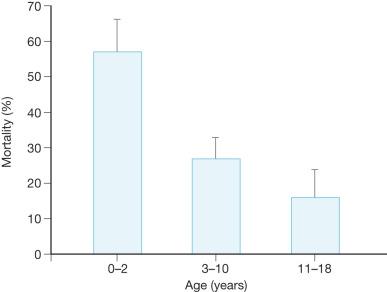
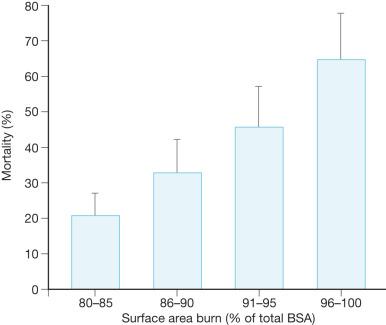
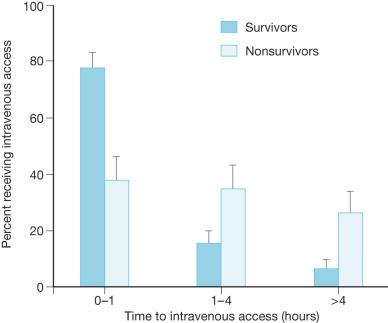
In addition to biological derangements, a severe burn produces tremendous psychological challenges to a child. Anatomical differences specific to the pediatric population make procedures and interventions more challenging.
First, the burn patient needs to be removed from the source of thermal injury expeditiously and clothing and jewelry removed immediately. Pouring cold water onto the burn can cause hypothermia in large burns and should be avoided. After the burning process is stopped, the patient should be kept warm by covering with a sterile (if available) or clean sheet or blanket. If the burn is chemical, the patient should be removed from the chemical immediately, and the burn should be irrigated with copious amounts of water for at least 30 min. If the chemical is powder, it should be brushed off first prior to irrigation.
Burn patients should be assumed to be trauma patients, and any potential life-threatening injuries should be identified and treated. The airway should be assessed first. One-hundred percent oxygen should be administered if inhalation injury is suspected. In addition, arterial blood gas and carboxyhemoglobin levels should be measured: pulse oximetry readings will be falsely normal in patients with elevated carboxyhemoglobin levels because carboxyhemoglobin is read as oxyhemoglobin by the pulse oximeter.
Tachypnea, stridor, and hoarseness indicate an impending airway narrowing due to inhalation injury or edema, and immediate intubation should be considered. A full-thickness circumferential chest burn can interfere with ventilation. Chest expansion should be observed to ensure adequate air movement. If the patient is on a ventilator, airway pressure and P co 2 should be monitored. If ventilation is compromised, escharotomy of the chest should be performed to improve ventilation.
Blood pressure measurement may be difficult in patients with burned extremities. These patients may require an arterial line to monitor their blood pressure. A radial arterial line may not be reliable in pediatric patients with extremity burns and may be difficult to obtain. A femoral arterial line may be more reliable and easier to secure.
An urinary catheter is placed to monitor urine output as a measure of successful resuscitation. Placement of a nasogastric tube is recommended in patients with severe burns because they can develop gastric ileus. Persistent tachycardia should alert a clinician to a missed injury or underresuscitation. Accurate and prompt determination of burn size is fundamental for the proper management of burn injury.
There is a systemic capillary leak after a major burn, which increases with burn size. Intravenous access should be established immediately for the administration of fluids. Delays in commencement of resuscitation of burned patients result in worse outcome. Therefore it is vital that IV access be obtained as early as possible. Due to the small circulating volume in children, resuscitation should be started immediately; even short delays increase the risk of shock. Peripheral IV access is preferred, and it must go through burned skin if necessary. IV access should be well secured. When peripheral IV access is not available because of severe extremity burns, a central venous line must be placed. Children with large burns should have two large-bore IV lines for fluid administration. The presence of two IV lines provides a safety margin if one stops functioning.
When vascular access is unobtainable, the intraosseous route is a viable option. Fluid volumes in excess of 100 mL/h can be administered directly into the bone marrow. Intramedullary access can be utilized in the proximal tibia until IV access is accomplished. A 16–18-gauge bone marrow aspiration needle, spinal needle, or commercially available intraosseous needle can be used to cannulate the bone marrow compartment. Although previously advocated only for children younger than 3 years of age, intraosseous fluid administration can be safely performed in all pediatric age groups. The proximal anterior tibia, medial malleolus, anterior iliac crest, and distal femur are preferred sites for intraosseous infusion. The needle should be introduced into the bone, avoiding the epiphysis, either perpendicular to the bone or at a 60-degree angle, with the bevel facing the greater length of bone ( Fig. 35.4 ). The needle has been properly inserted when bone marrow can be freely aspirated. Fluid should be allowed to infuse by gravity drip. The use of pumps should be discouraged in case the needle becomes dislodged from the marrow compartment.
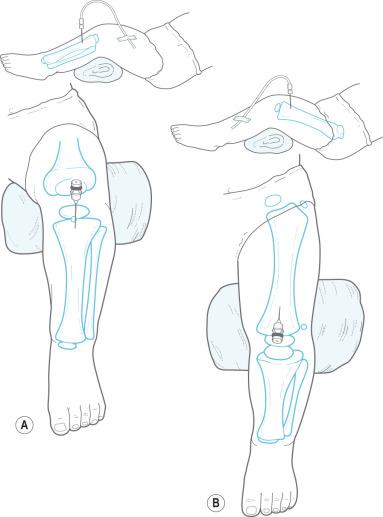
Fluid losses are proportionally greater in children owing to their small body weight-to-body surface area ratio. Normal blood volume in children is approximately 80 mL/kg body weight and in neonates 85–90 mL/kg, compared to an adult whose normal blood volume is 70 mL/kg. The commonly used “rule of nines,” useful in adults and adequate in adolescents, does not accurately reflect the burned body surface area of children under 15 years of age ( Fig. 35.5 ). The standard relationships between body surface area and weight in adults do not apply to children because infants possess a larger cranial surface area and a smaller area in the extremities than adults. The use in children of the most popular resuscitation formulas (initially designed for the adult population) can easily result in suboptimal resuscitation ( Table 35.1 ).
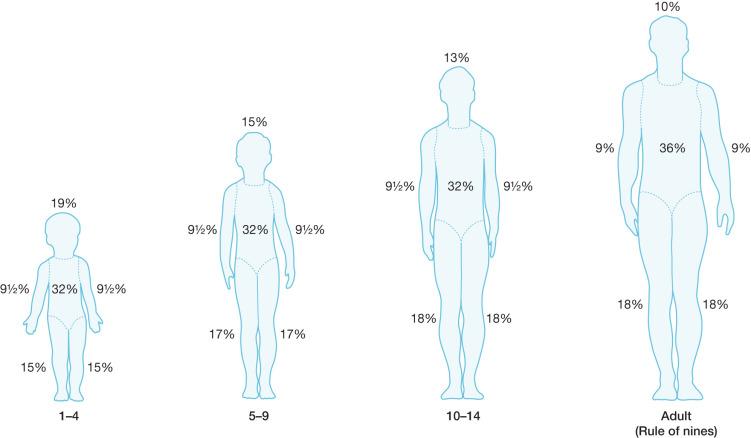
| CALCULATED NEEDS | REPLACEMENT BURN LOSS | ||||
|---|---|---|---|---|---|
| Example | % Burn | Resuscitation * | Maintenance † | mL | mL/kg/% |
| 1 year old | 15 | 600 | 800 | −200 | −1.33 |
| 10 kg | 30 | 1200 | 800 | 400 | 1.33 |
| 0.48 m 2 BSA | 60 | 2400 | 800 | 1 600 | 2.67 |
| 90 | 3600 | 800 | 2 800 | 3.11 | |
| 4 years old | 15 | 990 | 1200 | −210 | −0.85 |
| 16.5 kg | 30 | 1980 | 1200 | 780 | 1.58 |
| 0.68 m 2 BSA | 60 | 3900 | 1200 | 2 760 | 2.79 |
| 90 | 5940 | 1200 | 4 940 | 3.33 | |
| 12 years old | 15 | 2400 | 2250 | 1 150 | 1.92 |
| 40 kg | 30 | 4800 | 2550 | 2 550 | 2.12 |
| 1.13 m 2 BSA | 60 | 9600 | 2250 | 7 350 | 3.06 |
| 90 | 14,400 | 2250 | 12 150 | 3.38 | |
Pediatric burned patients should therefore be resuscitated using formulas based on body surface area, which can be calculated from height and weight using a standard nomogram ( Fig. 35.6 ) or formulas ( Table 35.2 ). The commonly used resuscitation formula in pediatric patients calls for the administration of 5000 mL/m 2 TBSA burned plus 2000 mL/m 2 TBSA for maintenance fluid given over the first 24 hours after burn, with half the volume administered during the initial 8 hours and the second half volume given over the following 16 hours. The subsequent 24 hours, and for the rest of the time their burn wound is open, the requirement is 3750 mL/m 2 TBSA burned or remaining open area plus 1500 mL/m 2 TBSA for maintenance. The fluid requirement decreases as a patient achieves more wound coverage and healing. As in the adult patient, resuscitation formulas offer a guidance for the amount of fluid necessary for replacing lost volume, and the amount of fluid should be titrated according to the patient's response. Resuscitation formulas have been incorporated into manual calculators, electronic devices, and smartphone applications in order to decrease the risk of error and increase the speed of calculation. Hyponatremia is a frequently observed complication in pediatric patients after the first 48 hours post burn. Frequent monitoring of serum sodium is necessary to guide appropriate electrolyte and fluid management. Children under 1 year of age may require more sodium supplementation because of higher urinary sodium losses. Hypernatremia can also develop, and it has been identified as an independent predictor of mortality in adult burn patients. Potassium losses are usually replaced with oral potassium phosphate rather than potassium chloride, as hypophosphatemia is frequent in this population. Calcium and magnesium losses also must be supplemented.
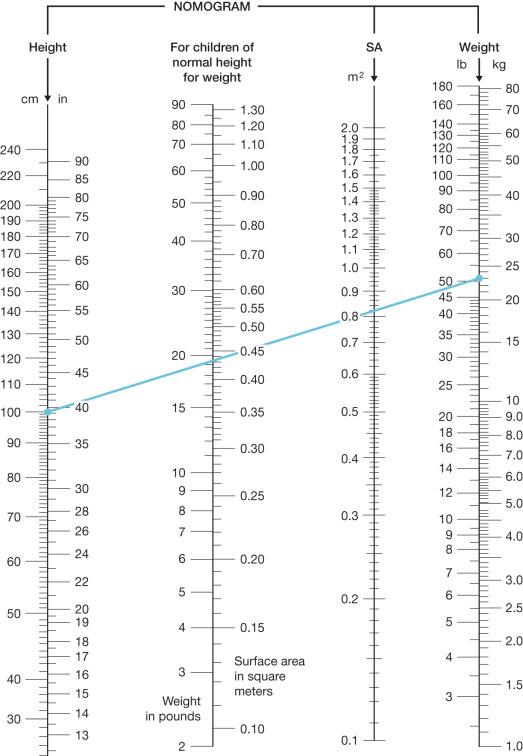
| Dubois formula | BSA (m 2 ) = ht (cm) 0.725 × wt (kg) 0.425 × 0.007184 |
| Jacobson formula | BSA (m 2 ) = [ht (cm) + wt (kg) − 60]/100 |
Intravenous resuscitation fluid should be isotonic and replace lost electrolytes. Lactated Ringer's solution is the most commonly used resuscitation solution for the first 24 hours post burn. Children less than 1 year of age should also receive a separate maintenance fluid solution containing dextrose to prevent hypoglycemia because their glycogen stores are limited.
The routine clinical signs of hypovolemia in adult burn patients, such as low blood pressure and decreased urine output, are late manifestations of shock in the pediatric patient, and tachycardia is ubiquitous. Due to their cardiopulmonary physiologic reserve, pediatric patients do not show overt signs of hypovolemia until a decrease of at least 25% of the total blood volume occurs; at this point, hemodynamic decompensation occurs abruptly. Changes in distal extremity color, capillary refill, pulse pressure, and mental status reflect volume status. Capillary refill is a good indicator of volume status in pediatric patients. Decreased capillary refill should warn a clinician of imminent cardiovascular collapse. Measurements of arterial pH, base deficit, and lactic acid are of particular importance in this age group, reflecting decreased tissue perfusion. Improvements in base deficit or lactic acid show successful resuscitation.
Normal blood pressure range varies according to age, with a systolic blood pressure of 100 mm Hg or less considered normal in patients younger than 9 years ( Table 35.3 ). Renal compensatory mechanisms for hypovolemia (e.g., tubular concentration) are not well-developed in young children, contributing to hypovolemia with sustained urine production despite reduced intravascular volume.
| Age | Minimum Heart Rate (beats/min) | Systolic Blood Pressure (mmHg) | Respirations (breaths/min) | Minimal Hemoglobin (g/dL) | Minimal Hematocrit (%) |
|---|---|---|---|---|---|
| <2 years of age | 100–160 | 86–106 | 30–40 | 11.0 | 33.0 |
| 2–5 years of age | 80–140 | 89–112 | 20–30 | 11.0 | 33.0 |
| 6–9 years of age | 70–120 | 97–115 | 18–25 | 11.5 | 34–5 |
| 9–12 years of age | 70–115 | 102–120 | 18–25 | 11.5 | 34–5 |
| >12 years of age | 60–110 | 90 | 12–20 | 12.0 | 36.0 |
An indwelling urinary drainage catheter is essential for burns of greater than 20% during resuscitation. During the early phase of resuscitation, urine output should be assessed hourly and the resuscitation fluid adjusted appropriately. Fluid administration should be titrated to achieve a urine output of 1 mL/kg/h in children and 2 mL/kg/h in infants. Initial fluid boluses should be administered in amounts appropriate to the size of the child and should be less than 25% of the total blood volume (20 mL/kg).
Overresuscitation must be avoided because it can lead to congestive heart failure, pulmonary edema, abdominal and extremity compartment syndromes, and cerebral edema in burn patients. In children, cardiac output depends mainly on the heart rate due to the low compliance of the heart, which limits increase in stroke volume. In addition, the heart is more susceptible to volume overload. Cardiac output can be measured using transpulmonary thermodilution devices, which are less invasive than a pulmonary artery catheter and only require an arterial catheter and a central venous line. Transthoracic or transesophageal echocardiograms should be used early to assess cardiac function in patients who are not responding to conventional therapy. Children are particularly prone to the development of edema from both vasogenic and hydrostatic sources. Vasogenic edema occurs in the early post-burn period when vascular integrity is impaired. The maintenance of intravascular osmotic pressures reduces the likelihood of edema development. In difficult resuscitation, colloids such as albumin can be used. Albumin can be expected to remain in the intravascular space if administered more than 8 hours after burn.
Airway evaluation and management must be given priority. Children are more prone to obstruction due to the smaller aperture of their trachea. Airway edema causes disproportionate increments in resistance with concomitant reduction of the cross-sectional area. Inhalation injury can lead to delayed airway edema after administration of massive resuscitation fluids.
Potential hemorrhage and edema make emergency intubation difficult. Hence, early intubation should be considered when a long transfer is anticipated, severe inhalation injury is present, or a patient has a large burn that likely will develop airway edema secondary to the large amount of fluid resuscitation. Concurrent placement of an endotracheal tube (ETT) over the bronchoscope should be considered at the time of bronchoscopy. A readily available estimate of airway diameter is the width of the patient's little finger, an age-based formula (age + 16)/4, or the use of a Broselow tape.
The ETT must be well secured. In a child, exudative wounds and moist dressings can make this task difficult. One successful approach is to attach the ETT with tape around the back of the head, both above and below the ears. An additional piece of tape over the top of the head, secured to the tape behind the head, will prevent accidental extubation in most children. In addition, commercially available endotracheal tube holders exist; however securing the tubes with tape strips of sufficient length and width has proved superior to two different commercial tube holders.
Become a Clinical Tree membership for Full access and enjoy Unlimited articles
If you are a member. Log in here